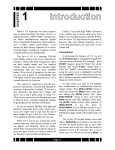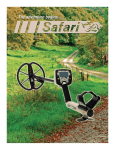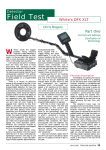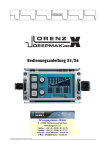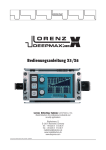Download RIDGID metal detector User manual
Transcript
1 Angela Street Mill Hill, Blackburn BB2 4DJ t: +44 (0)1254 55887 f: +44 (0)1254 676901 Metal Detectors e: [email protected] User Manual VK40 Thank you for purchasing the VK40 metal detector from VIKING. This is one of a family of microprocessor driven metal detectors that are very simple to use yet provide excellent performance. Push the drawer back into the detector until it clicks. Please note the drawer can only be inserted the one way. Please take time to read this booklet. It will guide you through each of the available features to ensure you get the best out of your detector. To disassemble the detector, loosen the coupling by turning it against the arrow and push in the spring button. The lower shaft will now slide out from the 'S' shaft. Your detector is now ready for use Getting Started 1. Unpack The Detector There are two main sections. The 'S' shaft, onto which is mounted the control box, and the lower shaft with the search head. Note the spring button near the end of the lower shaft. 1 2 3 2. Assemble The Detector Slide the lower shaft into the 'S' shaft, wrapping the cable snugly, but not tightly, round the shaft. When correctly aligned the spring button on the lower shaft will click into 1 of the 3 holes on the underside of the 'S' shaft. 3. Tighten the coupling Turn the coupling to the 'lock' position as indicated by the arrow. This makes a rigid connection between the two parts of the shaft. 4. Insert Battery The detector takes a single PP3 (alkaline) 9V battery. This is placed in the battery compartment on the rear of the control box. ENSURE THE BATTERY IS INSERTED THE CORRECT WAY ROUND 1 6 1. 2. 3. 4. 5. 6. 4 5 Detector Display On / Off Key Menu Down / Motion Key Pinpoint / Retune Key Menu Up / All-Metal / Non-Motion Key Menu Key Detection Modes The VK40 offers 3 methods of detection: Motion Mode When operating in motion mode the search head must be kept moving to enable an object to be www.metaldetectors.co.uk 1 Angela Street Mill Hill, Blackburn BB2 4DJ t: +44 (0)1254 55887 f: +44 (0)1254 676901 Metal Detectors e: [email protected] detected. In this mode the detector is silent until an object is detected when it emits a sharp beep. The sound occurs as the centre of the search head passes the target object. This is the only detection mode that provides discrimination. P All-Metal Mode This mode provides a continuous faint audio threshold tone, allowing the smallest signals to be detected. In this mode the audio output will continually, but slowly, retune to the threshold level preventing the detector from drifting out of tune, but requiring the search head to be kept moving to detect items. This mode is not available when detecting in Beach mode. When the detector is in either Motion or All-Metal detection modes, holding this key will switch the detector into NonMotion mode until the key is released. This allows for accurate pinpointing. When the detector is working in NonMotion, holding this key retunes the audio threshold to its preset level. ▲ Non-Motion Mode Similar to the All-Metal mode, this mode also provides a faint audio threshold through the speaker or headphones. In this mode the detector does not automatically retune, but enables the search head to be held stationary over the target to allow accurate pinpointing. In some cases changes in ground conditions and temperature may cause the threshold to vary from its faint preset level. In this case the detector needs to be retuned, When the detector is detecting in Motion mode, pressing this key will switch to AllMetal mode. Subsequent presses will alternately switch the detector between Non-Motion and All-Metal modes. When the detector is in Menu mode, this key will increment the currently selected setting. MENU This key switches the detector into Menu mode, allowing the Sensitivity, Discrimination and Ground settings to be adjusted and the Auto Power Off feature to be enabled or disabled. Membrane Keypad Detector Setup All the VK40's functions are controlled from the 5 keys on the front panel of the detector. Please read this section carefully to understand how these controls operate with each other. The VK40 provides a menu system to alter the detector settings which can aid with detecting. These settings are: Discrimination, Sensitivity and Ground. The effect of changing the value of each of these is described below: Pressing this key once will turn the detector on. When the detector has com pleted its startup sequence and is in detect mode, pressing this button again will turn the detector off. ▼ 2 will switch from the current detection mode to Motion mode. When the detector is in Menu mode, this button will decre ment the currently selected setting. When the detector is operating, this key Discrimination The Discrimination setting is used to alter the detectors ability to ignore unwanted metal objects when used in Motion mode. The higher this setting, the more discriminating the detector will be. When set at 0 all metal items will be www.metaldetectors.co.uk 1 Angela Street Mill Hill, Blackburn BB2 4DJ t: +44 (0)1254 55887 f: +44 (0)1254 676901 Metal Detectors detected, and when set to maximum (90) only the most conductive items (Silver and Copper) will be found. All other targets will be ignored. For normal detector use it is not recommended to search with the Discrimination set too high as many desirable targets may be missed. Items such as gold rings are not as conductive as a piece of copper so will be ignored by the detector if the Discrimination level is set too high. Sensitivity The Sensitivity level alters how responsive the detector is to signals received from the search head. The higher the Sensitivity level, the more responsive the detector. For general use it is recommended that the Sensitivity level is set to maximum (90), as this improves the detectors ability to locate small or deep objects. In some environmental conditions, the detector may produce false beeps which do not indicate a target. In this case is is recommended that the sensitivity setting is reduced until the problem is resolved. Ground The VK40 provides 2 different Ground settings for detecting in different conditions. The two settings are Inland and Beach. As wet sand has a different effect on the detector to soil, when the detector is used on the beach the Ground setting must be set to Beach. Menu Operation To adjust each of the settings described above, a simple menu system is used. The MENU key on the keypad is used to select which setting is to be adjusted, and the ▼ and ▲ keys are used to alter the value. With the detector switched on and operating, 3 e: [email protected] press MENU to enter the menu mode. This will cause the display to show the Discrimination and Sensitivity settings, and the current setting of the Sensitivity setting will flash: Adjusting Sensitivity While the Sensitivity value is flashing, pressing the ▼ or ▲ keys will decrement or increment the value, in steps of 5, respectively. Please note that the Sensitivity and Discrimination values are only adjustable in the range 0-90. Therefore pressing ▼ when the value reads 0, and similarly pressing ▲ when the value reads 90, will have no effect. To resume detecting, press the P key and the detector will exit the menu mode. Alternatively, if no key is pressed for a few seconds then the detector will automatically return to its normal operating mode. Whilst in the menu mode, pressing MENU again allows the Discrimination setting to be adjusted in the same way as that described above for the Sensitivity setting. A third press of the MENU button changes the display again: Changing Ground Mode Pressing either the ▼ or ▲ keys toggles the detector between Inland and Beach modes. Finally, after a fourth press of the MENU button the ▼ and ▲ keys can be used to toggle the Auto Power Off feature On or Off. www.metaldetectors.co.uk 1 Angela Street Mill Hill, Blackburn BB2 4DJ t: +44 (0)1254 55887 f: +44 (0)1254 676901 Metal Detectors From this stage of the menu mode, a subsequent press of the MENU key will return the detector to normal operation. Again, this can also be achieved by pressing P or waiting a few seconds. e: [email protected] battery fades, the height of the blocks will gradually reduce. When the bar fills up with blocks just one pixel high, "Low-Battery" will be read on the display and the battery should be replaced. Additional Features Target ID This part of the display provides an indication of the identity of each target. When the search head is swept past a target, a number - between 0 and 95 - is shown on the display and the bar displays a number of blocks dependant on the number shown. If only one or two blocks appear, and the number that appears is low, then the object is likely to be iron. If seven or eight blocks are shown, and the number is high, then the object is likely to be of high conductivity. Some typical targets are shown here: Nail 5p Shilling Battery Check The detector continually monitors the condition of the battery. When the detector indicates a target, the bar on the display fills up dependant on the object found. When the battery is in good condition the blocks will be the same height as all the other characters on the display. As the 4 Replace Battery Power Off Pressing the key will store the current detector settings and switch the detector off. Note: If the battery is removed without first switching the detector off, the current settings may not be stored. Auto Power-Off If the detector receives no signals for approximately 5 minutes, it will consider itself not to be in use and automatically switch off. This should not cause a problem in normal use and prevents battery draining should the detector accidentally be left switched on. This feature can be switched off, if desired, through the menu. Headphone Socket This is on the underside of the display box and will accept a standard pair of headphones with a ¼" stereo jack plug. The loudspeaker will be disabled when a plug is inserted into the headphone socket. Headphones are particularly recommended for searching in the Non-Motion or All-Metal modes. www.metaldetectors.co.uk 1 Angela Street Mill Hill, Blackburn BB2 4DJ t: +44 (0)1254 55887 f: +44 (0)1254 676901 Metal Detectors e: [email protected] Using Your Detector Firstly, switch the detector on using the key. Put the detector into Motion mode by pressing the ▼ key. Check the sensitivity level. It should be set at maximum (90). If it is not, press the MENU key once and then use the ▲ key to increasethe setting. At first it is best to work with the Discrimination level set at 0. Follow the earlier instructions for information on altering this setting. With experience a level will be found where most rubbish is ignored and desired objects still give an audio signal. This will be determined by trial and error and depends on the preference of the individual detectorist. To detect, hold the detector by the handgrip with your arm in the rest. Lower the search head to the ground ensuring that it is flat to the ground. If you feel the length of the shaft or the position of the armrest are wrong adjust them now. Keeping the head close and parallel to the ground, sweep it back and forth in an arc in front of you. The speed at which you sweep is not critical but remember that the machine is more likely to miss targets if you go too fast. Walk slowly forward as you sweep, allowing the area searched each time to overlap with that searched by the previous sweep to avoid missing targets. 5 The detector will emit a beep when an object is detected. The display will also give a target ID number as described earlier. Repeated sweeps are recommended to obtain a more accurate reading. The object can then be pinpointed either by pressing the Pinpoint button, or by switching to All-Metal or Non-Motion modes. In either of these modes the audio signal is loudest when the search head is directly over the target object. The target ID system is not infallible. The signals received from round steel objects, for example a washer or recent 2p piece, can confuse the detector. If repeated sweeps over a target give a wide range of numbers and the number of blocks shown on the display varies greatly this is the detectors way of telling the user that one of these 'problem' objects has been found. The choice to dig or not is up to the user. Remember that the display only acts as a guide. www.metaldetectors.co.uk 1 Angela Street Mill Hill, Blackburn BB2 4DJ t: +44 (0)1254 55887 f: +44 (0)1254 676901 Metal Detectors e: [email protected] Caring for Your Detector Warranty Service In order to keep your machine in good condition, please take the following precautions: Return of the enclosed guarantee card entitles the original purchaser to a full 2-year guarantee from the original purchase date. This covers parts and labour, excluding batteries. This does not, however, cover postage of the unit to or from our factory. This must be paid by the owner of the detector. • When using in bad weather, protect the electronics in the control box by wrapping in a waterproof bag. • Clean your detector regularly and ensure the shaft is free from dirt, especially sand. Use a damp cloth with mild detergent, but make sure no water gets into the control box. If the detector is stored for long periods remove the batteries. If they leak or corrode they could cause serious damage to the detector. In the unlikely event that you do need to return the detector to us, please pack it securely along with a letter explaining the problem and a cheque for £6.00 to cover return carriage and insurance to: Viking Metal Detectors 1 Angela Street Mill Hill Blackburn Lancs. BB2 4DJ Please make cheques payable to Viking Metal Detectors. If you are unsure about the fault please give us a call on (01254) 55887 and we will be happy to advise you. 6 www.metaldetectors.co.uk








